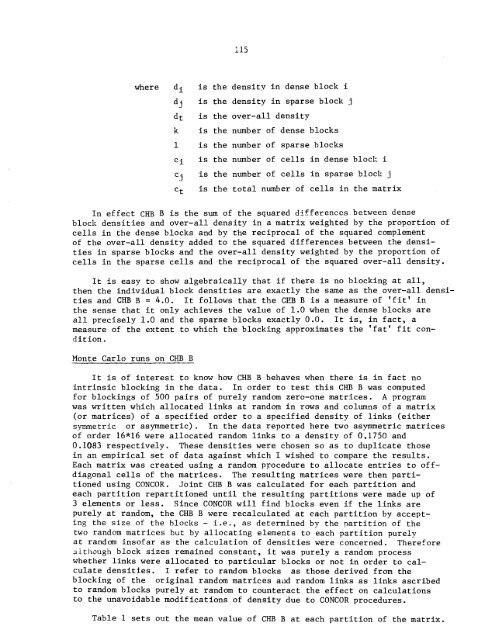(1985). Levine's Atlas of Corporate Interlocks. Connections ... - INSNA
(1985). Levine's Atlas of Corporate Interlocks. Connections ... - INSNA
(1985). Levine's Atlas of Corporate Interlocks. Connections ... - INSNA
Create successful ePaper yourself
Turn your PDF publications into a flip-book with our unique Google optimized e-Paper software.
1 15<br />
where di is the density in dense block i<br />
dj is the density in sparse block j<br />
dt is the over-all density<br />
k is the number <strong>of</strong> dense blocks<br />
1 is the number <strong>of</strong> sparse blocks<br />
ci is the number <strong>of</strong> cells in dense block i<br />
cj is the number <strong>of</strong> cells in sparse block j<br />
c t is the total number <strong>of</strong> cells in the matrix<br />
In effect CHB B is the sum <strong>of</strong> the squared differences between dense<br />
block densities and over-all density in a matrix weighted by the proportion <strong>of</strong><br />
cells in the dense blocks and by the reciprocal <strong>of</strong> the squared complement<br />
<strong>of</strong> the over-all density added to the squared differences between the densities<br />
in sparse blocks and the over-all density weighted by the proportion <strong>of</strong><br />
cells in the sparse cells and the reciprocal <strong>of</strong> the squared over-all density .<br />
It is easy to show algebraically that if there is no blocking at all,<br />
then the individual block densities are exactly the same as the over-all densities<br />
and CHB B = 4 .0 . It follows that the CHB B is a measure <strong>of</strong> 'fit' in<br />
the sense that it only achieves the value <strong>of</strong> 1 .0 when the dense blocks are<br />
all precisely 1 .0 and the sparse blocks exactly 0 .0 . It is, in fact, a<br />
measure <strong>of</strong> the extent to which the blocking approximates the 'fat' fit condition<br />
.<br />
MonteCarlorunsonCHBB<br />
It is <strong>of</strong> interest to know how CHB B behaves when there is in fact no<br />
intrinsic blocking in the data . In order to test this CHB B was computed<br />
for blockings <strong>of</strong> 500 pairs <strong>of</strong> purely random zero-one matrices . A program<br />
was written which allocated links at random in rows and columns <strong>of</strong> a matrix<br />
(or matrices) <strong>of</strong> a specified order to a specified density <strong>of</strong> links (either<br />
symmetric or asymmetric) . In the data reported here two asymmetric matrices<br />
<strong>of</strong> order 16*16 were allocated random links to a density <strong>of</strong> 0' .1750 and<br />
0 .1083 respectively . These densities were chosen so as to duplicate those<br />
in an empirical set <strong>of</strong> data against which I wished to compare the results .<br />
Each matrix was created using a random procedure to allocate entries to <strong>of</strong>fdiagonal<br />
cells <strong>of</strong> the matrices . The resulting matrices were then partitioned<br />
using CONCOR . Joint CHB B was calculated for each partition and<br />
each partition repartitioned until the resulting partitions were made up <strong>of</strong><br />
3 elements or less . Since CONCOR will find blocks even if the links are<br />
purely at random, the CHB B were recalculated at each partition by accepting<br />
the size <strong>of</strong> the blocks - i .e ., as determined by the partition <strong>of</strong> the<br />
two random matrices but by allocating elements to each partition purely<br />
at random ins<strong>of</strong>ar as the calculation <strong>of</strong> densities were concerned . Therefore<br />
although block sizes remained constant, it was purely a random process<br />
whether links were allocated to particular blocks or not in order to calculate<br />
densities . I refer to random blocks as those derived from the<br />
blocking <strong>of</strong> the original random matrices aiid random links as links ascribed<br />
to random blocks purely at random to counteract the effect on calculations<br />
to the unavoidable modifications <strong>of</strong> density due to CONCOR procedures .<br />
Table 1 sets out the mean value <strong>of</strong> CHB B at each partition <strong>of</strong> the matrix .

















